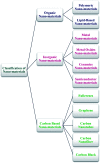Applications of nano-materials in diverse dentistry regimes
- PMID: 35495474
- PMCID: PMC9052824
- DOI: 10.1039/d0ra00762e
Applications of nano-materials in diverse dentistry regimes
Abstract
Research and development in the applied sciences at the atomic or molecular level is the order of the day under the domain of nanotechnology or nano-science with enormous influence on nearly all areas of human health and activities comprising diverse medical fields such as pharmacological studies, clinical diagnoses, and supplementary immune system. The field of nano-dentistry has emerged due to the assorted dental applications of nano-technology. This review provides a brief introduction to the general nanotechnology field and a comprehensive overview of the synthesis features and dental uses of nano-materials including current innovations and future expectations with general comments on the latest advancements in the mechanisms and the most significant toxicological dimensions.
This journal is © The Royal Society of Chemistry.
Conflict of interest statement
There are no conflicts to declare.
Figures














References
-
- Granjeiro J. M., Cruz R., Leite P. E., Gemini-Piperni S., Boldrini L. C. and Ribeiro A. R., Tin Oxide Materials ,Elsevier, 2020, p. 133
-
- Han J. Xiong L. Jiang X. Yuan X. Zhao Y. Yang D. Prog. Polym. Sci. 2019;91:1. doi: 10.1016/j.progpolymsci.2019.02.006. - DOI
-
- Pramanik S. and Sundar Das D., Two-Dimensional Nanostructures for Biomedical Technology, Elsevier, 2020, p. 281
-
- Liu P. Williams J. R. Cha J. J. Nat. Rev. Mater. 2019;4:479. doi: 10.1038/s41578-019-0113-4. - DOI
Publication types
LinkOut - more resources
Full Text Sources

